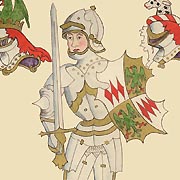Richard Neville, 16th Earl of Warwick, will forever be known as the "Kingmaker" due to the power he wielded during the Wars of the Roses.
EARL OF RICHES
The powerful magnate was born on 22 November 1428 to Richard Neville, Earl of Salisbury, and Alice Montague. The Nevilles had held Yorkshire strongholds since the 13th Century and Warwick's grandfather, Ralph, Earl of Westmorland, joined the family to royal lineage with his marriage to Joan Beaufort, youngest daughter of John of Gaunt and Katherine Swynford.
Richard's betrothal at six years-of-age to Anne Beauchamp would prove to be highly fortuitous when the Beauchamp earldom of Warwick passed to him aged 20. Warwick owned land in 18 counties, from Cornwall to Yorkshire, with the greatest concentration in the West Midlands including the majestic Warwick Castle.
 |
| Warwick's early foe, Edmund Beaufort, 2nd Duke of Somerset on horseback |
A land dispute in Glamorgan, Wales, with the Lancastrian favourite, Edmund Beaufort, 2nd Duke of Somerset, led Warwick to side with his uncle, Richard, Duke of York, in the tumultuous year of 1453.
There had been eight childless years of marriage between King of England Henry VI and his queen consort Margaret of Anjou and the birth of Prince Edward of Westminster in 1453 should have strengthened the reign of Henry VI. But the king's mental breakdown left the country without a ruler.
Henry VI's illness led to the king not acknowledging the existence of his son and Warwick contributed to court rumours that the baby boy was a bastard son born through an adulterous affair between the queen and Somerset.
Somerset's disastrous command of France led to his imprisonment in the Tower of London by York, now acting as Lord Protector following the king's incapacity. The head of the king's council, backed by Warwick and his father, was able to bring order and looked to balance the Crown's finances but York's peers were wary of the duke's true intentions.
York was soon to resign as Protector when Henry VI regained his senses on Christmas Day 1454 and Somerset's swift release from the Tower led to the Yorkist faction to retire to their estates. Warwick quickly began assembling an army along with York and Salisbury and the three nobles suspected that the royal court was moving against them after they received invitations for a Great Council meeting in Leicester that would discuss the king's safety 'against his enemies'.
IN COMMAND
York led his men south to intercept Henry VI's men before they reached Leicester and the two forces clashed at the First Battle of St. Albans.
The decisive moment in the battle came when Warwick led his men through inn gardens and attacked Lord Thomas Clifford's men holding the line against York and Salisbury's charges. The surprise attack from behind Clifford created a fierce battle through the streets of St. Albans and Warwick soon had the advantage when the Lancastrians fled.
Warwick instructed his archers to target the area around the king's royal standard on St. Peters Street and arrows rained down on the Lancastrian nobles. Clifford, Somerset, and Henry Percy, Earl of Northumberland, lay dead whilst Humphrey Stafford, Duke of Buckingham, and the king were struck in the face by Warwick's arrows. The king sought refuge in a tanner's house and was soon discovered by York. The Yorkist commanders knelt in front of their king and pleaded forgiveness for their actions in that they never intended to harm the king.
 |
| York and Warwick discover Henry VI's whereabouts (depicted by Graham Turner) |
Henry VI accepted and was escorted back to London alongside York and Salibury, with Warwick leading the way with the king's sword. After another bout of illness, Henry VI recovered in early 1456 and recognised York's influence in court by awarding Warwick Captain of Calais on 20 April 1456. Warwick courted favour with the town's powerful wool merchants with financial rewards and began to build a vital power base in England's last French domain.
POPULAR
Warwick's popularity in London increased when he stopped Italian traders from taking an unlimited supply of English wool after the Italians exploited a royal licence that was granted to them.
The queen looked to maneuver against the Yorkists by negotiating terms with her uncle, King of France Charles VII, in exchange for military support. The French seized on this and attacked the English south coast town of Sandwich and whispers spread throughout court that Margaret was behind the attack in order to antagonise Warwick across the Straits of Dover in Calais.
 |
| Warwick's new foe - Queen Margaret |
Discontent rumbled throughout the land due to Margaret's attempts of conscription and the raging battle between the northern Neville and Percy families, led Henry VI to look for peace and initiated talks in early 1458. The arrival of Sir John Clifford, and other nobles whose fathers were slain at St. Albans, threatened to disrupt the talks but Warwick, York and Salisbury agreed to pay for a chantry in the town and further compensated the fallen families.
The talks culminated in a public display of harmony between Yorkist and Lancastrian supporters on Loveday, 24 March 1458. Henry VI led the procession of harmonious inter-family couples with Warwick, following behind York and the queen, knowing that peace would be short lived.

My 19th great grandfather
ReplyDelete